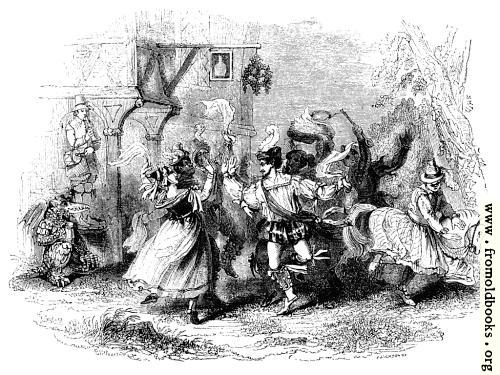
"that at the high feast of Pentecost especially, afore al other high feasts in the yeare, he would not goe that day to meat until he had heard or seene some great adventure or mervaile. And for that custom all manner of strange adventures came before King Arthur at that feast afore all other feasts."
Morte d'Arthur - chapter cxviii. Sir Thomas Malory (c1405-1471)
A 'Whitsun Ale' was a parish celebration held originally to raise money for Church funds. The whole village would take a day off and as the name suggests a large quantity of ale would be brewed for the festival. The custom mirrored the courtly practice of holding feasts and tournaments at Whitsuntide as described by Thomas Malory.
A Whitsun Ale was a very big affair in most villages. A King and Queen of the Day would be appointed, there would be archery competitions, games and Morris Dancing. In 1557 St Mary’s Church in Reading paid for some of the performers: 'Item payed to the morrys daunsers and the mynstrelles, mete and drink at Whytsontide, iijs. iiijd.' The Gildhouse at Poundstock in North Cornwall is one of the very few buildings still standing where we know Whitsun Ales took place. You can see it at http://www.poundstockgildhouse.co.uk/.
An edict of Queen Elizabeth I in 1569 gives us some idea of what games might have been performed:‘the shooting with the standard, the shooting with the broad arrow, the shooting at twelve score prick, the shooting at the Turk, the leaping for men, the running for men, the wrestling, the throwing of the sledge, and the pitching of the bar, with all such other games as have at any time heretofore or now be licensed, used, or played.'
It is now believed by scholars that Morris Dancing originated as a court entertainment in the late fifteenth century – there is a record of it being performed London in 1504. It has nothing to do with Moors and it doesn’t come from Spain. By the time the court had passed on to more entertaining diversions, ordinary people had taken Morris Dancing to their hearts. The politics of the early 20c folk lore revival movement are Machiavellian, many researchers of the time either ignoring evidence or making it up to support their own theory as to the dance’s origin and rules.

So we can picture a bucolic village scene - rosy cheeked maidens serve hearty tankards of ale to their rustic swains, happy peasants dance the Morris, old women gossip and old men snooze all in a haze of May sunshine, benevolently regarded by Priest and Lord. Well – maybe.
The Whitsun Church outings and Tea Treats of the nineteenth and early twentieth century are descendents of these early parish feasts. Tea Treats were often held in Cornwall usually in association with the local Methodist Chapel. There would be a parade with banners and then a huge tea around a groaning table of food – and definitely no ale!
So I think a traditional cake is called for, as made by some parish lady of the nineteenth century. This is from my Grandmother’s hand written recipe book circa 1900. I’ll give it you as she wrote it.
Lorne Cake
½ lb flour
½ lb butter
½ lb sifted sugar
1 tablespoonful milk
2 tablespoons grated chocolate
2 oz currants
1 teaspoon lemon essence
1 teaspoon vanilla essence
1 teaspoon baking powder
½ tsp cinnamon
2 oz Valencia raisins stoned and chopped
3 eggs.
Beat butter and sugar to a cream, then add eggs and milk and flour mixed with the baking powder. Beat well. Divide the mixture into three parts and to each part: 1. Add the fruit and cinnamon, 2. Add the chocolate and vanilla, 3. Add the lemon essence. Bake. Cover with almond icing and afterwards with plain icing. Particularly good with no icing.
I substituted self raising flour for the plain, and the rind of 1/2 a lemon plus a tablespoon of juice for the lemon essence. I then weighed the mixture and divided it into 3x10z portions. I baked the cakes for about 20 minutes at 170c and then sandwiched them together with an almond flavoured butter cream filling. It was scrummy!
I can’t find a definitive origin for Lorne cake but it may have been invented for the marriage of the Princess Victoria to the Marquis of Lorne in 1871. A marriage that caused raised eyebrows because he was so lowly born!
And leve the hilles hee,
And shadow him in the leves grene
Under the green-wode tree.
Hit befell on Whitsontide
Early in a May mornyng,
The Sonne up faire can shyne,
And the briddis mery can syng’
‘May in the Green Wode’ - Anonymous 15th century poem.
Thanks to Nick Cahill for the information about Poundstock.
5 comments:
I've just changed from Microsoft to Apple and its a bit like swapping from a cart horse to a race horse in mid race. The font and the picture issue here are victims of my failure to come to terms with the race horse called iMac. I'll get better soon - promise.
Liz
I've just printed off a local history of the parish that I live in , Penketh, and it has lots about the Methodist teas and parades and they still make fabulous cakes when they put on a christmas fair.I shall try your grandmother's recipe.thankyou.
It's a good one, I tested it out this week on my friends at the Library - universal thumbs up. The fruit layer makes it.
Another really interesting post and a delicious looking Lorne cake. Particularly interested in the Poundstock Gildhouse - we go there to visit friends fairly often so will take a bit more interest next time we're passing.
Hello Liz
nice to meet you! :)
Have a nice week. K
Post a Comment